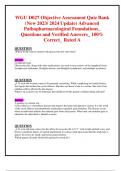WGU D027 Objective Assessment Quiz Bank (New 2023/ 2024 Update) Advanced Pathopharmacological Foundations _ Questions and Verified Answers _ 100% Correct _ Rated A QUESTION Where do the cancers treated with glucocorticoids stem from? Answer: Lymphoid tissue - Glucocorticoids, along with other medications, are used to treat cancers of the lymphoid tissue (lymphocytic leukemias, Hodgkin disease, non -Hodgkin lymphomas, and multiple myeloma). QUESTION A 23 -year-old woman comes in for prenatal counseling. While completing her family history, she reports her brother has cystic fibrosis. She does not know if she is a carrier. She asks if her children will be affected by the disease. What is an accurate way to determine the likelihood of this patient's children being affected? Answer: A genetic or a carrier test - Cystic fibrosis is a hereditary disease that impacts the lungs and digestive system. It is the result of the cystic fibrosis transmembrane conductance regulator gene mutation. The disease occurs when an individual inherits the mutated gene from each parent . When only one mutated gene is inherited, the individual is labeled a carrier. QUESTION A 31 -year-old man comes into the office for an exam. He is 6' 5 " with a high -pitched voice, and he has a moderate degree of mental impairment. It is discovered upon exam that his body hair is sparse, his testes are small, and he has gynecomastia. Which genetic disorder should this patient be tested for? Answer: Klinefelter syndrome - Klinefelter syndrome is a hereditary disease also known as 47,XXY or XXY that manifests as the series of symptoms described. The symptoms are expressed as a result of the presence of two or more X chromosomes in males. It is often not diagnosed until adult hood. QUESTION A six -month -old female infant with failure to thrive comes in to the office with her parents. It is noticed upon exam that the patient has facial deformities and is jaundiced. A complete blood count (CBC) is ordered, which reveals anemia. When that patient 's blood is examined under a microscope, the red blood cells appear small and abnormally shaped. A mutational analysis is ordered, and alpha thalassemia is diagnosed. What is the likelihood of incidence of these parent's future children having alpha thalassemia? Answer: 25% - Alpha thalassemia is a hereditary blood disorder characterized by reduction in hemaglobin production. Each individual inherits two copies of the HBA1 gene and two copies of the HBA2 gene from each parent. If at least one copy of the four is missing, a vari ation of alpha thalassemia can result. That means that future offspring have a one in four chance of the disease. QUESTION Which chamber of the heart has the thinnest muscle in the heart? Answer: Right atrium - The ventricles possess cardiac muscles that are the thickest lined chambers of the heart because their blood volume burden must be pumped to the lungs and the rest of the body, which are areas of high resistance. The atria receive blood from either the res t of the body via the vena cava (right) or lungs (left). They must only pump the volume directly to the ventricles. The coronary arteries encircle the chambers of the heart to supply the nutrients needed to keep the tissue alive. QUESTION During diastole, which part of the heart is filling with blood? Answer: Both ventricles - Systole reflects the perfusing pressure of the cardiovascular system where the ventricles eject blood from the heart. Once complete, a resting period —diastole —follows, where blood must refill the ventricles directly from the collection that occurred in the atria. QUESTION Oxygenated blood flows through which vessel? Answer: Pulmonary vein - The superior vena cava carries all the deoxygenated blood from peripheral circulation back to the heart where it enters the right atrium to be pumped into the right ventricle. The right ventricle pumps to the lungs for oxygenation via the pulmonary artery. After pulmonary circulation, the oxygenated blood is carried back to the heart via the pulmon ary vein. QUESTION Which complex (wave) represents the sum of all ventricular muscle cell depolarizations? Answer: QRS - The QRS wave of an electrocardiogram (ECG or EKG) represents the largest spike in electrical activity of the heart, as ventricular muscle cells perform the highest burden of work to pump blood volume out of the heart in that instance. QUESTION What effect does atherosclerosis have on the development of an aneurysm? Answer: Erodes the vessel wall - Atherosclerosis, also known as the process of "hardening of the arteries" and secondary to plaque formation, weakens the flexibility of a blood vessel wall. Without vascular compliance, the vessel wall becomes more rigid and susceptible to rupture (i.e., an aneurysm). QUESTION What is the effect of oxidized low -density lipoproteins (LDLs) in atherosclerosis? Answer: LDLs cause smooth muscle proliferation - Within the arterial wall subintima, oxidized LDLs stimulate macrophage foam cell formation and proinflammatory pathways, which lead to smooth muscle proliferation, fatty streak creation, and eventual fibrous plaque overlays (McCance, p. 699 & 1072). QUESTION Which factor is responsible for the hypertrophy of the myocardium associated with hypertension? Answer: Angiotensin II - Angiotensin II leads to myocardial hypertrophy, poor myocardial compliance, and ventricular dilation through stimulating increased cardiac preload and afterload and direct toxicity to myocardial cells. It causes sarcomere death, abnormal collagen matrices, and interstitial fibrosis (McCance, p. 1099). QUESTION Most cardiovascular developments occur between which weeks of gestation? Answer: Fourth and seventh weeks - During weeks four to seven, the primitive heart tube progresses through numerous stages of development leading to a developed heart with distinct atria, ventricles, and cardiac vessels. QUESTION Which compensatory mechanism is spontaneously used by children diagnosed with tetralogy of Fallot (TOF) to relieve hypoxic spells? Answer: Squatting - Spontaneous squatting helps relieve hypercyanotic events in older children through increasing systemic vascular resistance, decreasing venous blood return. This provides a larger amount of




